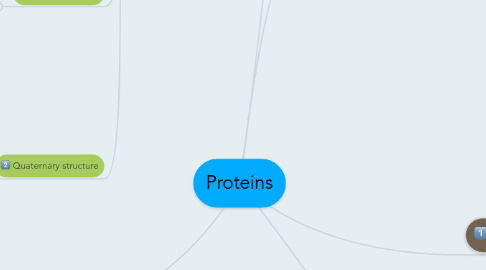
1. formation of a protien
1.1. the alpha carboxyl group is joined to the alpha amino group of another amino acid by a peptide bond
1.1.1. leads to the formation of a chain of amino acids called a peptide bond
1.1.2. forms a peptide bond
1.1.3. condensation reaction
2. protein stucture
2.1. primary structure
2.1.1. the sequence of amino acids in the polypeptide chain
2.1.2. each amino acid is linked by peptide bonds
2.1.3. disulphide bridges are also part of the primary structure
2.1.3.1. important in protein folding
2.2. secondary structure
2.2.1. the areas of finding or coiling within a protien
2.2.1.1. alpha helices
2.2.1.2. beta pleated sheets
2.2.2. amino acids interact non-covalently (hydrogen bonding) between the amino acid side chains
2.2.3. hydrogen bonding coils the polypeptide into a stabilised secondry structure
2.2.3.1. resulting in alpha helix
2.2.3.2. or when polypeptides lie parallel to each other beta pleated sheets
2.2.4. alpha helices
2.2.4.1. form when protein chains coil due to hydrogen bonds which form between non-adjacent backbone carbonyl groups and amide groups
2.2.4.2. R groups all extend outside the helix
2.2.5. beta pleated sheets
2.2.5.1. form when protein chains form layers over each other
2.2.5.2. are stabilised between neighbouring polypeptide chains
2.2.5.3. are stabilised by hydrogen bonds between the carbonyl O atom on one chain and the NH group on the adjacent chain
2.3. tertiary structure
2.3.1. the final 3D shape of a protein
2.3.2. the function of a protein depends on the tertiary structure
2.3.3. the forces which give rise to and stabilise the tertiary structure are
2.3.3.1. ionic bonds
2.3.3.1.1. salt bridges and electrostatic interactions between side chains of amino acids
2.3.3.2. hydrogen bonding
2.3.3.2.1. occurs between side chains between the hydrogens on one amino acid and the hydrogens on another amino acid
2.3.3.3. hydrophobic interactions
2.3.3.3.1. in water soluble proteins non-polar amino acids are located on the hydrophobic inside of the molecule away from the hydrophilic medium surrounding the protein
2.3.3.3.2. hydrophobic regions are further stabilised by Van der Waals forces
2.4. Quaternary structure
2.4.1. involves the clustering of several individual polypeptide chains into a final and precise 3D shape
2.4.2. stabilisation of tertiary structure
3. main categories of proteins
3.1. fibrous
3.1.1. elongated molecules whose secondary structure is the dominant structural feature
3.1.2. insoluble in water and physically tough
3.1.3. provide mechanical support to cells and to entire organisms
3.1.4. polypeptide chains form a single repetitive structure which is twisted regularly and arranged in bundles or sheets
3.2. globular proteins
3.2.1. are relatively sepherical
4. general functions of protiens
4.1. enzymes
4.1.1. digestion ( trypsin, pepsin, amylase)
4.1.2. metabolism
4.2. transport and storage
4.2.1. oxygen transport
4.2.2. fatty acids transport
4.2.3. iron storage
4.3. structural support
4.3.1. skin and bone (collagen)
4.3.2. elastic ligaments (elastin)
4.4. immune protection
4.4.1. antibodys
4.5. movment
4.5.1. muscle contractions (actin and myosin)
4.6. hormones
4.6.1. blood glucose regulation ( insulin and glycogen)
5. amino acids
5.1. Are the building blocks of proteins
5.2. contains
5.2.1. Carbon
5.2.2. hydrogen
5.2.3. oxygen
5.2.4. Nitrogen
5.2.5. and sometimes sulphur
5.3. each amino acid consists of the central alpha carbon to which the following groups are attatched
5.3.1. a hydrogen atom
5.3.2. a carboxyl (COOH) group
5.3.3. An amino (NH2) group
5.3.4. a unique R group or side chain
5.3.4.1. determines amino acid properties
5.4. amino acids have two functional groups
5.4.1. an amino functional group
5.4.2. a carboxyl functional group
5.5. properties of amino acid R groups
5.5.1. non-polar
5.5.1.1. have non polar R groups and are hydrophobic
5.5.2. polar
5.5.2.1. are hydrophilic, form weak hydrogen bonds with other polar molecules of water
5.5.3. some amino acids have charged R groups
5.5.3.1. negatively charged amino acids are acidic
5.5.3.2. positively charged amino acids are basic
